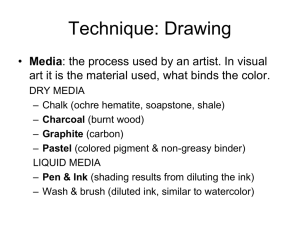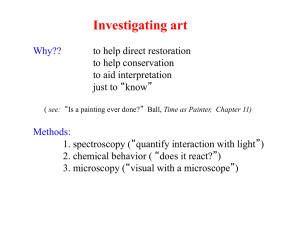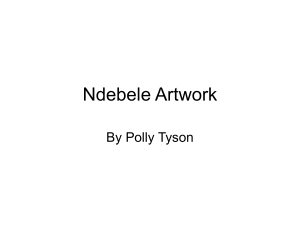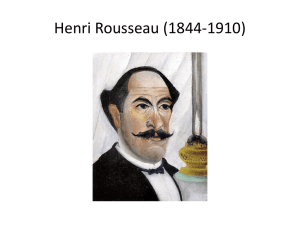Lecture11_HI_In_Art
advertisement
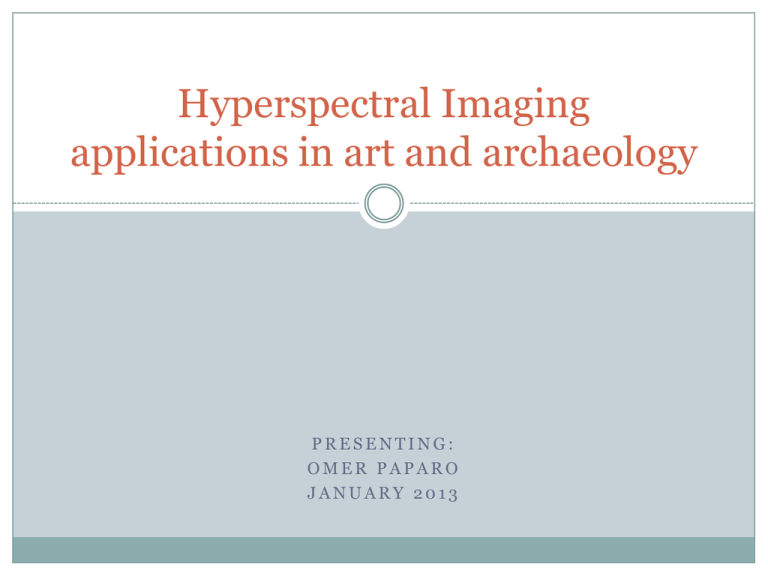
Hyperspectral Imaging applications in art and archaeology PRESENTING: OMER PAPARO JANUARY 2013 Agenda Introduction Motivation Limitations Spectral imaging systems Pigment identification The Kubelka-Munk theory of reflectance Investigating materials present on artifacts Revealing hidden information In paintings Studying archaeological manuscripts Art conservation Conserving paintings Best illuminants for viewing art Introduction Motivation Traditional methods are often invasive E.g., micro-chemical analysis of images HI is non invasive Can be carried out essentially on any object Can be carried out anywhere on an object Limitations Requires exposure to light Some artifacts suffer light-induced ageing Not always as accurate as traditional methods Invasive chemical analyses, for instance, almost always yield more chemically specific information Spectral imaging systems Illumination Light exposure must be kept at a minimum (both duration and intensity) Assuming the reciprocity principle ~200 lux for oil paintings, ~50 lux for manuscripts Wavelength selection Wavelength selection through illumination Only a selected wavelength range of light is incident on the object at a time Economic exposure, yet sensitive to background light Wavelength selection in the reflected light Light reflected from the object can be separated spectrally Can collect spectral data sequentially or simultaneously Detector Spectral imaging systems Working scheme: Spectral imaging systems Measurement at the Uffizi Gallery, Florence, Italy - Leonardo room Pigment identification Introduction – What are paintings made of? A pigment is a colored material ground into a fine powder After the grinding it is suspended in some type of media that acts as a binder to hold the dry pigments pigment together E.g. linseed oil for oil paints Over the eras, many different pigments were used Pigment identification E.g., the late gothic palette Pigment identification E.g., the late Italian Renaissance palette Pigment identification The main challenge is unmixing measured reflectance to separate reflectances of different materials Linear unmixing won’t work here – the mixing is not linear (materials can be mixed almost to atomic level) Pigment identification Measuring reflectance is relatively easy Suppose we’ve measured for some pixel, for same wavelength 𝐼 𝜆, the reflectance 𝑅 = 𝐼 0 The ratio between the outgoing light and the incoming light Now what? That reflectance, R, must be a combination of reflectances of more than one material found in that pixel But how can we separate them? Maybe the combined reflectance is a linear combination of those reflectances? • Well, not exactly Introducing the Kubelka-Munk theory of reflectance Pigment identification The Kubelka-Munk Theory of Reflectance: −𝑑𝑖 𝑇 = −(𝑆 + 𝐾)𝑖 𝑇 dx +𝑖𝑅 Sdx 𝑑𝑖𝑅 = −(𝑆 + 𝐾)𝑖𝑅 dx +𝑖 𝑇 Sdx Where K is the absorption coefficient and S is the scattering coefficient Pigment identification The Kubelka-Munk Theory of Reflectance (cont’d): It thus can be achieved that 𝑑𝑖𝑅 𝑖𝑅 − 𝑑𝑖𝑇 𝑖𝑇 = d 𝑙𝑛 𝑖𝑅 𝑖𝑇 = −2(𝑆 + Pigment identification The Kubelka-Munk Theory of Reflectance (cont’d): Rearranging and integrating we get: Solving this yields 𝑙𝑛 and 𝑏 = 𝑎2 − 1 So assuming: 𝑅−𝑎−𝑏 𝑅−𝑎+𝑏 ∗ 𝑅′ −𝑎+𝑏 𝑅′ −𝑎−𝑏 𝑅 𝑑𝑟 𝑅′ 1+𝑟 2 −2 𝑆+𝐾 𝑟 𝑆 =𝑆 = 2𝑏𝑆𝑋, where 𝑎 = 𝑋 𝑑𝑥. 0 𝑆+𝐾 𝑆 𝑅′ = 0 (no light gets to the back) 𝑋 → ∞ (particle sizes are much smaller than the thickness of the layer) We can achieve that 𝐾 𝑆 = 1−𝑅∞ 2 2𝑅∞ Pigment identification The Kubelka-Munk Theory of Reflectance (cont’d): Other than cases in which the absorption is very high or the scattering is very low, a mixture of different paint components can be modeled as a linear combination of K/S (weights are according to concentrations) Can predict components of mixture! Graph shows mixture of read earth and azurite in egg tempera KM can fail E.g., in the mix of pure indigo and orpiment Would not have failed if the indigo was mixed with lead white Pigment identification But generally, KM is robust Can handle varying: Concentrations Binding medium Particles size Investigating materials present on artifacts Similarly to pigment identification, we can perform analysis on 3D objects E.g., exploring the surface of Michelangelo's David Basically the sculpture is made of marble, but over the years some “guests” have joined Investigating materials present on artifacts Collecting and analyzing the data A UV (𝜆 = 337 nm) excitation light is provided by a nitrogen laser that generates 1 ns pulses Assuming mono-exponential behavior of the fluorescent −𝑡 emission, f, we get that 𝑓 𝑡 = 𝐴𝑒 𝜏 (per pixel) N pulses are delivered and the emission is measured Where 𝐴 is the amplitude and 𝜏 is the effective lifetime Given the pulse was provided with delay d, we can acquire the 𝑑+𝑤 −𝑑 −𝑑+𝑤 𝜏 𝜏 fluence: 𝐻 𝑑 = 𝐶 𝑑 𝑓 𝑡 𝑑𝑡 = 𝐶𝐴𝜏 𝑒 −𝑒 Where 𝑤 is the gate width and 𝐶 is a constant dependent on the efficiency of the detection system Investigating materials present on artifacts Collecting and analyzing the data (cont’d) The effective lifetime 𝜏 and the amplitude 𝐴 can be reconstructed by least mean squares fit performance on N time samples: Can build matrices of τ and 𝐴 Investigating materials present on artifacts Results Spectral signature is different than the one of “pure marble” Investigating materials present on artifacts Results (cont’d) Can identify organic compounds Investigating materials present on artifacts Results (cont’d) Can identify remains of beeswax David’s surface underwent a conservation treatment based on beeswax in 1813 Revealing hidden information For paintings: Maximum penetration of most paints can be achieved at wavelengths of around 2 μm At wavelengths around 1-2 μm, the common drawing materials, namely iron gall ink and sepia, become invisible Can use this to see underdrawings and preparatory sketches Revealing hidden information A Byzantine icon at 640nm (a) and 1000nm(b) Revealing hidden information Pablo Picasso – “The Tragedy” Revealing hidden information The optimal spectral window to visualize such features varies with the material used as well as the thickness of the paint layer Man, ~1100nm Horse, ~1350nm Sketch, ~1600nm Revealing hidden information A painting by Sellaio 520nm 885nm RGB Revealing hidden information Revealing hidden information Studying archaeological manuscripts “Soft media” ancient documents (i.e. documents written on soft materials such as leather or papyrus) are often unreadable The carbon-black ink is faded beyond recognition The carbon-black ink indistinguishable from the surface Not to mention the document itself is found in shreds Revealing hidden information Studying archaeological manuscripts Can use IR to read previously invisible texts and scripts The dead sea scrolls can only be seen through IR light Art conservation Conserving Paintings Can fix damage using hidden information revealing techniques The color image is derived from inter-band comparisons Art conservation Conserving Paintings (cont’d) Conservation monitoring Can identify continual damage to paintings, for example From a lamp in front of the painting From a pipe going through the ceiling Art conservation Best illuminants for viewing art Which one looks better? Art conservation Best illuminants for viewing art (cont’d) An illuminant for appreciating art is considered better if number of discernible colours is greater Illuminants are measured in degrees Kalvin Art conservation Best illuminants for viewing art (cont’d) The experiment: 1. Collect hyperspectral data from five different paintings Art conservation Best illuminants for viewing art (cont’d) The experiment: 2. Calculate the illuminant spectra 3. Compute the painting representation in CIELAB Art conservation Best illuminants for viewing art (cont’d) The experiment: 4. Count the number of non-empty unit cubes in the CIELAB space, and select best illuminant Concluding Today we have seen: Basic structures of spectral imaging systems for art and manuscripts Uses for hyperspectal imaging in art and archeology: Identifying pigments used for paintings Investigating materials present on artifacts Viewing underlying sketches for paintings Studying old and corrupted-by-time documents Conserving art Protecting art from harm Viewing in with best illuminant References H. Liang - Advances in multispectral and hyperspectral imaging for archaeology and art conservation – 2011 C. Fischer and I. Kakoulli - Multispectral and hyperspectral imaging technologies in conservation: current research and potential applications – 2006 J. K. Delaney et al - Visible and Infrared Reflectance Imaging Spectroscopy of Paintings: Pigment Mapping and Improved Infrared Reflectography – 2009 F. Voltolini et al - Integration of non-invasive techniques for documentation and preservation of complex architectures and artwork J.A. Carvalhal et al - Estimating the best illuminants for appreciation of art paintings G.H. Bear-man et al - Archeological Applications of Advanced imaging Techniques D. Comelli et al - Fluorescence Lifetime Imaging and Fourier Transform Infrared Spectroscopy of Michelangelo’s David - 2005 Thank you Questions?
